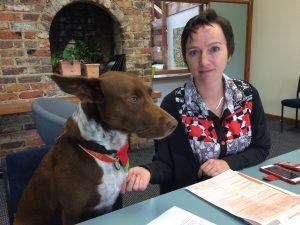
Over the past seven years or so, I’ve been honing my dog-sneaking skills. I have tried, somewhat successfully, to include my dog Finnigan in all aspects of my professional life. He sits at my feet while I work with my students. He comes to the schools I consult to whenever they’ll let him. He regularly attends my professional development workshops for teachers and parents.
This year, I’ve topped it all by managing to include two photographs of him on page 20 of my new book Reading for Life. His image will now occupy a small space on bookshelves all over the world.
I do this because I like him a lot and I like it when he’s around. He’s the sort of dog other people like too, in that he’s very serene and enjoys a good pat. He is also quite goofy and he smells terrific.
Other things I like working with and having around me are my fountain pen and the desk in my office. I’m really very lucky. But what if I told you that my students made progress because of my fountain pen? What if I said their sight word vocabulary increased as a direct result of my desk? You’d be perfectly justified in telling me to quit my delusions.
And yet, with tedious regularity, I see stories of miraculous ‘reading dogs’ helping children learn to read, trotted out in what can only be slow news weeks up and down the country.
Learning to read is a complex process that takes time, practice and effort. It is staggeringly easy for some, and frustratingly difficult for others. But no matter who is learning it, the acquisition of literacy follows much the same sequence. Some just do it at warp speed with very little instruction, some do it on a much slower timeline and require massive amounts of instruction and repetition. What it doesn’t require, is the presence of a fountain pen, a nice desk or a dog.
Positive reinforcement is not the same as instruction. If you have a budget for literacy floating around your school, perhaps teacher training, decodable reading material and valid assessment tools should be the first priority. Then when you’re successfully teaching 95% of your students to read and are making sure the 5% trailing behind are getting the best possible intervention, then perhaps you could think about spending the thousands it takes to have a ‘reading dog’ on site. Surely that’s fair?
So when you hear breathless accounts of how reluctant readers were drawn out of their catatonic states and blossomed into bookworms “because dogs”, do remember to ask how these children became reluctant readers in the first place. Reading failure is traumatic. Low quality instruction leads to reading failure.

I don’t mean to sound negative, but I’m the one who has to sit with the crying parents who are led to believe their child is beyond instruction. I’m the one who has to hear my students talk about how stupid they think they are. I’m the one who has to scribble over Individual Learning Plans and ask for strategies and goals that will actually lead to reading. Some of these students come from schools who have invested in ‘reading dogs’. Fancy that.
Much as my dog is pleasant to have around, my students’ progress has nothing to do with him. I have the luxury of being able to admit that. This is because I know what to do to help a child become a reader. Like any practitioner who understands and can apply the science of reading, so far I’ve had a 100% success rate. Until your school can say the same, cute, furry creatures are very nice, but ultimately are a waste of time, money and effort.

Well said, Lyn. For a couple of thousand dollars a school can start their decodable text library and make a very real difference to children. Keep the posts coming!
I bet you know that I’m an absolute dog lover too! And I even occasionally have students read to one of my dogs (NO Charge!). But I am so glad you’re pointing out that some really important resources are “must haves” and need to take precedence over the “nice to haves”! Thanks again for all the sensible things you share. I’ve not ever read something you’ve written that I don’t agree with (as far as I recall!). Can’t say the same for some of the strange theories/voices “out there” speaking about literacy without any real knowledge/science behind what they say!
My daughter loves to read to the dog. She does this because at 13 she is embarrassed and ashamed at how difficult she continues to find reading. She was not taught to read at school. $3000 spent on decodables or PD for early years teachers in systematic phonics instruction would be a much better investment for ALL students. Dogs don’t teach kids to read. Chasing brigh and shiny new things is not good enough and won’t get teaching the ‘professional’ status is deserves.
Yes reading is hard, it is challenging and needs to be explicitly taught. I too believe that it is important to invest in quality teachers; strategic, targeted teaching and quality support for all of our students, particularly those who do struggle, whether it be in literacy, numeracy or socially. I am a primary school teacher with over 25 years experience in Prep – Yr 6 and I now also have the role at my school of Primary Learning Leader (PLL). I also know what to do to help a child become a reader. My role as PLL involves tracking and monitoring every student ‘s learning progress in our school (all 340 of them). I also sit with teachers and using this data (both literacy and numeracy) develop/plan strategic, targeted cycles of teaching that will benefit students and continue to move them on as learners. This teaching happens in the classroom, in small targeted groups and in some cases individually if the need is quite significant and can’t be addressed within the “normal” classroom context. With everything we put in to place, the meetings we have with parents, the support that is given to students, sometimes limited or no progress has been made. We have this issue in our school, as I would think all schools do. We are one of those schools who has, as you say in your article “invested in reading dogs”. We have amazing programs, teachers, explicit, strategic reading instruction and quality support for all the students in our school but we still have some children struggling and some suffering “reading anxiety”, in much the same way as children (and adults for that matter) suffer “maths anxiety”. I am the volunteer at our school and it is my dog that comes for two morning sessions a week and listens to 10 children from Yr1 to Yr3 read. We have just started this program in our school and in just 2 weeks, the change in the attitude and demeanour of these 10 children who come to read to my dog has been a joy to see. In fact after just one 20 minute session, 1 child went home to his mum and said he loved reading with Asta because, in his mum’s words to the teacher, all the pressure was taken away because it was just Asta he was reading to. My dog “Asta” does not teach these children to read, the children know that. Asta’s job is to lay there beside them, snuggle up to them, be there with them and listen, perhaps even fall asleep! She relieves their literacy anxiety. I hope as someone who’s role it is to support struggling learners, you have not just relied on newspaper reports or tv news segments to get your information about Story Dogs, but you have used your skills as a critical reader and visited the Story Dog website and read about the program and perhaps even spoken to the co-founder Janine Sigley to fully understand the program. Story Dogs does not say it teaches children to read, it says it supports children and helps them to gain confidence and overcome “literacy anxiety” and that it does this through dogs because as those who are dog owners know, they have unconditional love and they don’t care if you stammer over words, take 5 minutes to read a page or have to sound out words, they will just sit there or lay there until the child is finished. Another comment you make is that money would be better spent on resources etc rather than “spending the thousands it takes to have a reading dog on site”. If you have visited the Story Dog website or spoken to Janine Sigley you would know that the schools pay nothing for a story dog to be in their school. Story Dogs is a not for profit organisation and the people who take their own dogs in to the schools are volunteers. The only thing that Story Dogs asks from a school in return is to have 1 fund raising day per year to help support the program. We are not chasing “bight new shiny things”, story dogs has been around for 10 years and I believe that when we as educators investigate all the ways we can support our young people and implement initiatives in to schools, whether it be through literacy, numeracy or mental health, knowing that one size does not fit all and one approach does not suit every learner, then it does get teaching the professional status it deserves. I would suggest that rather than write negative and at times sarcastic comments about a program you obviously don’t know very much about, you should visit the schools were it is happening, talk to the teachers of the children involved, sit in on some sessions and finally, talk to the children and their parents, then you will be able to write an informed and educated article and perhaps even be more open-minded towards some of the innovative initiatives that are out there to help engage and support our children in their learning.
Hi Wendy,
Thanks for getting in touch. I have a question: what form does your literacy instruction take? Because from some of the things you’ve said, I’m guessing that the children do some form of analytic phonics in the classroom (like THRASS or Soundwaves), then Guided Reading/LLI in small groups, then Reading Recovery/LLI as a 1:1 intervention. Did I get that right?
Once I know this information, then I can answer your post more fully.
Kind regards,
Lyn